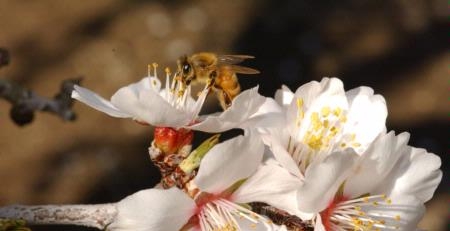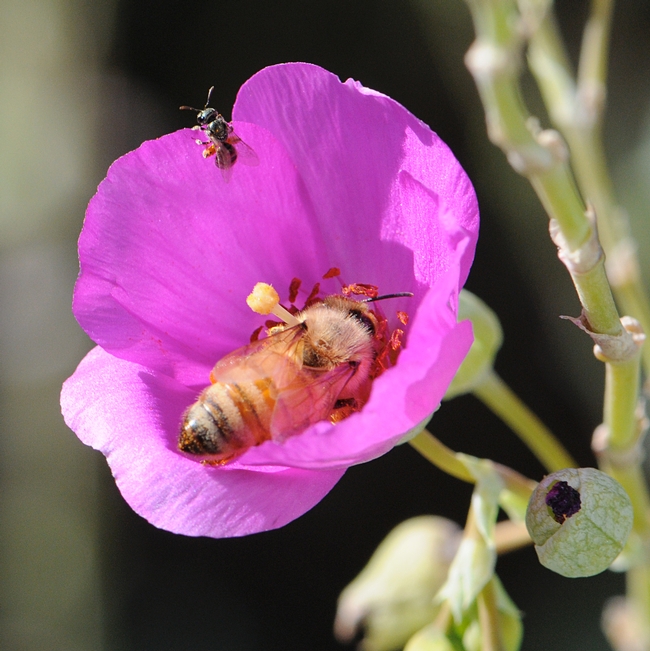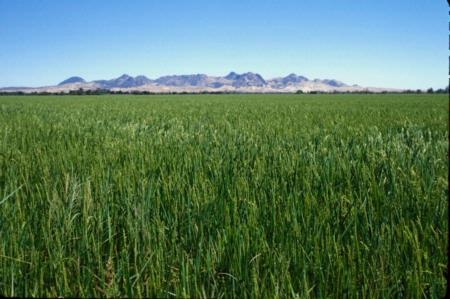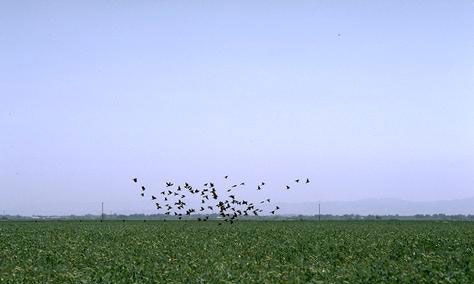Posts Tagged: bees
Urban environments are refuges for bees
Holland focused on the work of Gordon Frankie, an urban entomologist at UC Berkeley. He has been studying the foraging habits of native bees in Costa Rica to find out how much they forage in urban gardens.
Costa Rica has 800 bee species; Gordon's team has collected 112. They found that in most cases, a plant specimen located in an urban setting attracts as many bee species as does its wild counterpart. Occasionally, city specimens actually get more bees than the wild ones. As many as 80 percent of the native bees observed in wild settings were also visiting the urban gardens.
“That was higher than we expected, and it gave us hope. As more natural areas are disappearing or being impacted by humans, urban areas offer something more stable — people are looking after them," Frankie said.
Frankie is also monitoring the status of native bees in California, where there are 1,600 species, the article said. Gordon and his team have found 90 species of bees in the San Francisco Bay Area and East Bay region. Gardeners can help local bees by putting the Best Bee Plants for California around their homes.
Frankie also has a new book for sale, California Bees and Blooms: A Guide for Gardeners and Naturalists, $28 from Heyday Books.
Drought has some farmers planning to sell their water instead of crops
California's unrelenting drought is causing some farmers to consider pulling out of the food production business, reported Mark Korba on CNBC.
Bruce Lindquist, UCCE specialist in the Department of Plant Sciences at UC Davis, told the reporter that some farmers have decided to sell their water instead of trying to grow a crop. In fact, water is at such a premium, it is impacting the sale of farmland in California.
"It used to be location, location, location when it came to sales, but now it's water, water, water," said a real estate agent interviewed for the story.
The story included an interview with Northern California rice producer Sherry Polit.
"If we keep going through this drought, it may make us quit and sell the ranch," she said. "We've been rice farmers for 31 years and growing olives for five," she said. "But we just can't take this anymore. We've got to get some rain or this could be over."
Bees Butler, UC Cooperative Extension specialist in the Department of Agriculture and Resource Economics at UC Davis, said a drop-off in California rice production will likely have an effect on global markets in time. However, in the immediate future, there is rice in storage to meet world needs.
Keeping an eye out for the birds and the bees
A UC Davis study found that the population of tricolored blackbirds in California is falling dangerously low, reported Kurtis Alexander in the San Francisco Chronicle.
The birds, which numbered in the millions 100 years ago, are now down to about 145,000 in all. One reason for the decline, the article said, is the agricultural harvest. Before agriculture dominated the landscape, the birds nested in the valley floor's native tules, shrubs and grasses. The birds adapted to nesting in the vast fields of wheat, oats and other crops grown to feed dairy cattle. However, when the crop is harvested, many birds are caught up in the equipment, said Robert Meese, a researcher in the Department of Environmental Science and Policy at UC Davis.
The USDA is working with dairy owners to protect the young birds and some dairy operators are voluntarily delaying harvest until the baby birds can fly away, the article said.
Bees.
In San Diego, the Board of Supervisors is coming to the aid of the state's ailing bee population, said an article by Mark Walker in the San Diego Union-Tribune. The board has voted to open up county land for beekeepers who are finding it hard to place bees in areas where they can forage for nectar.
The county wants to foster more beekeeping in the face of dwindling populations from the mysterious colony collapse disorder. More hives could help honey production and farmers who need bees for their crops, the article said.
Insects.
Another insect - this one a pest - is the subject of stunning photos in a recent National Geographic feature. Photographer Sam Droege of the USGS Patuxent Wildlife Research Center captured a shot of an Asian citrus psyllid pierced by the tip of a needle that shows every tiny hair on its legs and every lens of a bulging red eye.
The article reviewed some of the research now underway to prevent the spread of huanglongbing disease of citrus, a tree killing scourge that is spread by Asian citrus psyllid. Among the possible solutions are breeding Asian citrus psyllids that can't carry the disease, genetically modifying citrus to be resident and introducing natural enemies of the pest.
One natural enemy under study at UC Riverside, Tamarixia radiata, appears in a photo that's part of the NatGeo spread. The image, by David Littschwager, shows an army of Tamarixia radiata with translucent yellow abdomens artfully back lit. The wasps were first collected in Pakistan by UC entomologist Mark Hoddle, who traveled to the Middle East to collect psyllid predators in their native range. Before being approved for biocontrol use, Tamarixia underwent a lengthy USDA evaluation intended to ensure that it wouldn't harm any native psyllids. It is now being released in ACP-infested citrus trees, where they are being carefully monitored for year-to-year survival.
California cows going to 'greener pastures'
At the World Ag Expo in February, nine states had booths designed to recruit California dairy operators out of the Golden State, reported the Los Angeles Times.
South Dakota Governor Dennis Daugaard himself made a personal appeal for the state, where ag officials estimate that a single dairy cow creates $15,000 in economic activity each year.
In recent years, an average of 100 California dairies have closed annually, said Leslie "Bees" Butler, UC Cooperative Extension specialist in the Department of Agricultural and Resource Economics at UC Davis.
"Ten years ago, California was the low-cost producer," Butler said. With low milk prices and high feed costs, "it's become more difficult to dairy here."
Tweaking feed recipes can go a long way toward protecting farmland in and around dairy farms
Joshua Emerson Smith, The Merced Sun-Star
Overfeeding salts and other minerals to dairy cows can negatively affect soil and groundwater quality, according to a research report in the Journal of Dairy Science by Alejandro Castillo, UC Cooperative Extension advisor in Merced County.
"This is going to be important for the sustainability of our dairy farms," he said. "We need to try to see the future and imagine the sustainability of our dairy farms and maintain the business for a long time."
A new lease on life
The Davis Enterprise
A series of photos by Sue Cockrell from the recent "groundbreaking" ceremonies for the new home of UC Agriculture and Natural Resources in Davis.
California weather has been perfect for almond set
The warm, dry late winter weather in California has been good news for almond farmers who were concerned about a bee shortage during bloom, reported Capital Press.
"It looks good right now," said Rich Buchner, UC Cooperative Extension advisor in Tehama County. "The bees are out working like crazy. It's going to be warm and dry over the next 10 days, so it should be about perfect for almond set."
Almond growers are enjoying a vibrant blossom season even though California only had about 500,000 bee colonies available as of mid-February to pollinate this year's crop of 800,000 acres, according to Eric Mussen, UCCE specialist in the Department of Entomology at UC Davis. Typically, as many as 1.6 million are needed to provide two colonies per acre.
The favorable weather for bee activity comes with a catch, however. Precipitation totals are behind seasonal averages.

A honey bee on an almond blossom. (Photo: Kathy Keatley Garvey)




